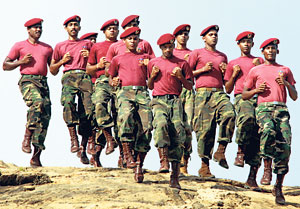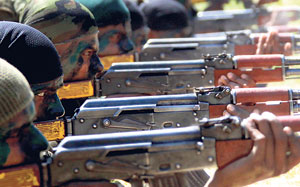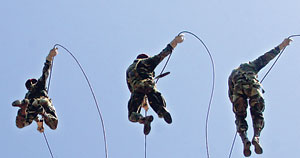Captain Samangi Vidanage of the Sri Lanka Army Women’s Corps made history when she passed out as a paratrooper from the Commando Regiment Training School in Uva Kuda Oya in December 2009 becoming the very first female officer in Sri Lanka to do so. Together with Cpl. Niroshini Hemanthi and Cpl. Sriyalatha Kahawela, who passed out with her, they were the first women paratroopers in the Sri Lanka Army, although there have been a few female paratroopers in the Sri Lanka Air Force.
Not content to rest on their laurels, the three indomitable young women are now doing a follow-up Freefall Course, which would qualify them as sky divers.
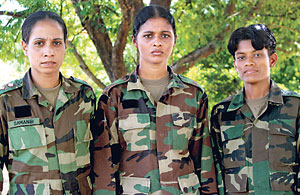 |
| Flying high: Samangi, Hemanthi and Sriyalatha |
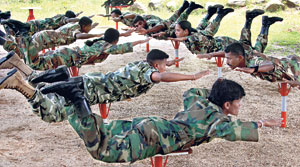 |
| Training with the men. |
The Sunday Times travelled to the Kuda- Oya camp to find out how the young women master these rigorous skills. Samangi, the youngest and only girl in a family of four brothers joined the army in 1997, after completing her A’L examination at St. Sebastian’s in Kandana. After a year of training at Diyatalawa, she passed out in 1998 as a 2nd Lieutenant and since then had served in Anuradhapura, Jaffna, Mannar and Omanthai. She was Commanding Officer of 250 troops of 4th Battalion Women’s Corps, engaged in defence and guard duty.
In September 2009, vacancies were announced for one officer and two others from the Women’s Corps, for paratrooper training. It was the first time this offer was made to the Women’s Corps. Nominations were sent from six battalions of the Women’s Corps. Finally, after an initial test in Colombo and two physical training tests in Uva Kuda Oya, Samangi, Hemanthi from the 4th Battalion SLAWC and Sriyalatha from the 3rd Battalion, were selected from among 17 candidates.
Two weeks of ground training at the Commando Regiment Training School in Uva Kuda Oya, followed, involving rigorous physical training together with male troops. “We were taught how to act on landing, jumping from two feet, four feet, and how to roll and get up without pressure on the legs,” Samangi said. It was far from easy, she concedes. “In the first days of training we were dead beat. Our feet swelled. However, after two weeks the knees and ankles were strengthened. We were also introduced to the parachute,” she added. “There are instruments to simulate how to hang from the chute and control it with the wind and how to turn.”
On November 23, the 40 participants of the training course had their first jump at the Air Force Uhana camp in Amparai. A Y12 aircraft was used for the jump made from 1000 feet. “After taking off, we were taken round and shown the dropping zone,” Samangi said. “The Jump Master gives the command. The door is kept open and four to five exit from the door at a time.” The chute, which has a diameter of 35 feet, opens after falling 60 feet. “At the first jump, when exiting with the parachute, we were a little nervous and confused. However, it improved with the second and third jumps.
As we jump we go down at an angle due to the wind and flight speed. At that time we cannot think or feel anything. It’s like losing consciousness and being revived when the chute opens. We had to learn how to control the chute and go towards the target with the wind. We had no problem with the target. A luminous arrow marked the dropping zone. We had to complete five jumps including a night jump. During the night jump, there were no lights at all, only the luminous arrow seen halfway through the jump.”The sixth jump was an exhibition one at the passing out parade, where their parents were present.
Samangi had a word of appreciation for the riggers who pack the chutes. The chute opens only if it is packed correctly and there is a reserve chute in case of any problem with the main chute. “The chute weighs about 35 kilos. There is special training for riggers. It takes half an hour to pack one chute. Jumps are done every other day so that the chutes can be packed in between. “We jump with confidence in the riggers,” Samangi said. She added that their experiences in the operation areas during the war helped them to withstand the rigors of the training.
At the Commando Regiment Training School (CRTS), the three women are among ten participants selected for the advanced Freefall Course. The other participants are commandos and Special Forces personnel. When we visited CRTS, they were being trained in exiting from the aircraft and movements until the opening of the chute. In the Basic Parachute Course, a cable is fastened to the parachute at one end and hooked to the aircraft at the other. The cable gets detached from the parachute when it opens. In the Freefall Course, the parachutist exits from between 10,000 to 14,500 feet, falls free of the aircraft and descends to 3,500 feet when the chute is opened manually or automatically. To qualify as a skydiver they have to complete 25 jumps.
Cpl. Hemanthi and Cpl. Sriyalatha are both from Dehiattakandiya. They echoed similar experiences to those of Captain Vidanage. Seeing the army camps in the vicinity of their home, Hemanthi said she developed a desire to join the army from her schooldays. She was an athlete while in school at Veheragala MV. Sriyalatha too has participated in National Cross Country Marathon and badminton and also in the Defence Services Games and been successful. They are both PT instructors in their units. After their course they would be called to the CRTS to serve as PT instructors for the paratrooper training courses. “We are really happy we did this course, Sriyalatha said.
“We have gained a great deal from it.”
Encouraged by the success of the first three female paratroopers in the Sri Lanka Army, three more from the Women’s Corps have been selected for the current Basic Parachute Course, which is the 53rd course conducted. Captain Aruni Perera, has served 12 years in the Army and is the mother of a three-year-old. Cpl. Surangi Wijesinghe has served eleven years in the army, while Cpl. Dinusha Maduwanthi has five years service. Chosen from 27 applicants, and still engaged in ground training, Aruni said they found it somewhat hard at the start but are now looking forward to making the jumps.
The making of commandos
‘Nothing Impossible’ is the ambitious motto the Commandos of the Sri Lanka Army are trained to achieve. The Commando Regiment Training School (CRTS), at Uva KudaOya, strives to equip the commandos with the skills to perform the duties expected of them.
Located in Uva KudaOya, beyond Tanamalwila in the Monaragala district, the training school is set in 4000 acres of tropical forest, spreading across the villages of Kitul Kote, Balaharuwa, Athiliwewa. The dense jungle and rugged terrain of the area makes it ideal for training in jungle warfare.
The CRTS has two wings, the Commando Training Group and the Parachute Training Group, explained Col. Jayantha Balasuriya, Commandant of the school. The Commando Squadron was initiated and started training in 1978, under the leadership of Major S.D. Peiris, as there was a requirement for Special Forces personnel. It was formally inaugurated on March 15, 1980. The commandos were first deployed in anti-hijack and hostage release duties at the Bandaranaike International Airport. At the time there was a threat of aircraft hijacking in the world.
With the expansion of the army, the Commando Squadron was upgraded to 1st Commando Regiment on March 15, 1986. Today there is a Commando Brigade with five regiments deployed all over the country, with its headquarters in Ganemulla. The Brigade Commander, Maj. Gen. Srinath Rajapakse is responsible for the operational matters of the commandos.
Four of the regiments are deployed in operational areas while the 4th Commando Regiment is engaged in anti-hijack and hostage release duties, VIP protection and the handling of the War Dog group. There have been three occasions when the commandos successfully practised hostage release. Set up in Ganemulla in 1980, the Commando Regiment Training School was moved to its present home at Uva KudaOya in 1993.
Col. Balasuriya says new recruits are specially selected for commando training and sent first for basic army training for four months. When they return to the CRTS, they follow a month-long Commando Orientation course. This is followed by the grueling 36-day Commando Selection Course. Only those who qualify are selected for the Commando Course and those who do not make the grade are sent to other Army units.
The 32-week commando course includes individual skill development, small team skill development, hostage release and counter terrorism including anti-hijack and VIP protection, jungle patrolling exercises under bivouacs and shelter preparation with their own groundsheets.
The trainees have to live in the jungle under their own shelters for a period. Instructors follow and observe. Their training also involves live firing, which is only used in commando training, Col. Balasuriya said. “We have found these exercises very effective in warfare. When foreign trainees come to CRTS, we introduce more live fire training and jungle tactics as this is what they come for mainly.”
During Eelam War 4, with the need for commandos in the Sri Lanka Army growing, the CRTS aimed to be able to train 1000 commandos at a time. Consequently, facilities were upgraded, making CRTS one of Sri Lanka’s premier training grounds for jungle warfare.
For the final jungle patrolling exercise they go to Alutwela. “Whatever they learn here, will be put into practice there,” says Col. Balasuriya. “Everything else is done within the camp.”
The current Commando Course was started with 1023 trainees, who underwent orientation. After the selection course only 688 ORs and 20 officers have qualified to go further. Those who finally graduate as Commandos are given a maroon beret, which is the hallmark of every commando in the world.
“This beret has to be achieved by sheer hard work,” Col. Balasuriya said.
Parachute training was inaugurated in 1990 at Ganemulla, where 49 courses have been conducted. The Parachute Training Group was moved to Uva KudaOya in 2009.
CRTS offers a wide variety of courses to service personnel from friendly foreign countries, particularly on small unit level tactics in jungle warfare.
Ideally, every commando should have parachute training. “They should be able to insert into a battlefield by land, sea or air. However, in Sri Lanka, our facilities for airborne training are limited, as we have only forty chutes. We have to give them parachute training in batches. We now have over 1000 commandos with parachute training,” Col. Balasuriya said.
CRTS has 190 instructors, who are all commandos. Major Sujith Siranjeew, Senior Instructor, Parachute Training Group, an experienced parachutist is a Jump Master who has done 410 parachute jumps.
Major Upul Pilapitiya, Chief Instructor of CRTS, who conducts commando training is also qualified in parachuting. He has 13 years of experience as a commando and has served in the Long Range Patrol behind enemy lines in the North and East. “My responsibility here is to make sure all training is progressing as per programme,” Maj. Pilapitiya said. “We want to produce good commandos for the Regiment and Sri Lanka Army.
“This is the only training school in South Asia, with commando training and parachute training in one place,” said Col. Balasuriya adding that they have even conducted the commando and airborne training of Maldivian Special Forces. |



